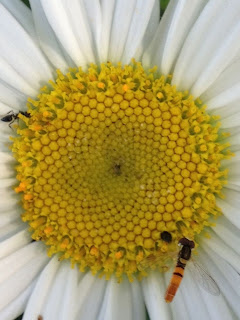Amongst oh so many summer activities most of you are sure to indulge in: swimming, camping, eating watermelon, attending barbecues, visiting with family and friends, playing computer games, going to the movies, and much, much more; do find some time to be outside for 50 seconds and to look around.
It does not matter where you are: the beach, the city, the suburbs, the mountains, etc. because you will be amazed at what you see. Here's what you need to do:
Locate an outdoor spot [it can be anywhere] Here's a few suggestions:
- a sidewalk
- a flowerpot
- the edge of a parking lot
- base of a tree
Then just stand quietly and observe.
- What do you see?
- Are there patterns?
- Is there any movement?
Take a good look because you are about to witness a world with activity. Notice the grasshopper leaps effortlessly.
Here's a clip, but you need to look very closely to see nature's miracles:
©2013DearTeachJMW
Grasshopper, notice his false eyes sure to frighten his enemies. Did you see him jump! What a landing!
[Edited by Casey Waltz]
©2013DearTeachJMW
Look closely at his false eyes!
©2013DearTeachJMW
Deep in the center of the screen, motionless, a juvenile praying mantis [as seen from the top and
side views].
©2013DearTeachJMW
Closeup of Praying Mantis
©2013DearTeachJMW
He is stretched out between two flower buds.
Can you see him?
He is facing the left side of the screen.
Praying Mantis all grownup...one month to the day...
 |
| Praying Mantis, turns to glaze and then climbs glass door ©2013DearTeachJMW |
©2013DearTeachJMW
Busy bees move from catmint floweret to floweret in a bit of a frenzy!

A bit of information
 |
| See which parts of the daisy's cross-section you can match up with this image. Which common terms do you see? What conclusion can you draw about the parts of flowers? |
©2013DearTeachJMW
©2013DearTeachJMW
©2013DearTeachJMW
©2013DearTeachJMW
Notice the pattern. What does it resemble?
Notice the two insects, what are they?
 |
| Cross-section of a daisy |
©2013DearTeachJMW
A blade of grass sets root within
two tree trunks.
What does this tell you about
nature?
©2013DearTeachJMW
Clover finds itself a home against a
concrete wall.
Some general things to do:
Find out about pollination, how exactly do bees and other insects retrieve the nectar, the current concerns over the diminishing bee population, just how do grasshoppers launch themselves, where do the praying mantis lay their young, how does a clover become a 4 leafed clover, what are the parts of grasses, what is it about their root systems that enable them to anchor themselves practically anywhere, where does moss come from, why does it tend to grow only in the southern exposure of host plants; make up your own question, and locate a satisfactory answer.
And so it is, our world is teeming with tiny creatures and plant life who go about their business without a care. They do not concern themselves with the ongoings around their environs, instead they delight in the simple joy of existence.
So, the next time you are outside, anywhere, stop and look! What do you see? Grab your smart phones, or Ipads and make a clip. You can create a digital portfolio of this summer's 50 Seconds of Nature's Sightings. All one needs is patience, and you will see creatures you never imagined existed beneath your very feet.
Soon the insignificant becomes the most significant for its simplicity and beauty.
Have fun kids!
The Teach
The Teach









